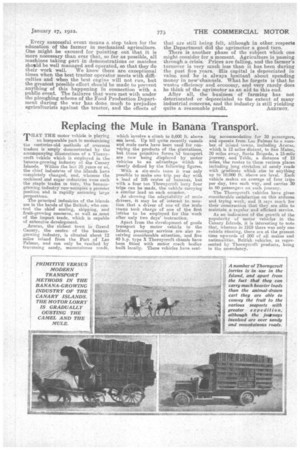Replacing the Mule in Banana Transport.
Page 25

If you've noticed an error in this article please click here to report it so we can fix it.
THAT THE motor vehicle is playing an inseparable part in modernizing the centuries-old, methods of overseas traders is amply demonstrated by the accompanying illustrations of a Thorny, croft vehicle which is employed in the banana-growing industry of the Canary Islands. Within the last 20 years or so, the chief industries of the islands have completely changed, and, whereas the cochineal and sugar industries were each the staple trades in turn, the bananagrowing industry now•occupies a premier position and is rapidly assuming large proportions.
The principalindustries of the islands are in the bands of the British; who control the chief coaling, shipping, and • fruit-growing concerns, as well as moat of the import trade, which is capable of extensive development. Arucas, the richest town in Grand • Canary, the centre of the bananagrowing industry, is situated about 12 miles inland from the Port of Las Palmas, and can only be reached by traversing sandy, moimtainens roads,
which involve a climb to 8,000 ft. above sea level. Up till quite recently camels and mule carts have been used for conveying .tbe products of the plantations, but these primitive forms of transport are now -being displaced by motor vehicles to an advantage which is clearly defined by the following figures..
With a six-mule team it was only possible to make one trip per day with a load of 105 crates of bananas, but with a four ton Thornycroft lorry four trips can be .made, the vehicle carrying
a similar load on each occasion. •
As showing the. adaptability of mule drivers, it may be of interest to mention that a driver of one of -the Mule teams took charge of one of the first lorries to be employed for this work after only two days' instruction.
Apart from the development of goods transport by motor vehicle in the Island, passenger services are also receiving considerable attention, and five 40 h.p. type X Thornycroft chassis have been fitted with motor coach bodies built locally. These vehicles have seat ing accommodation for 30 passengers, and operate from Las Palmas to a number of inland. towns, including Arucas, which is 12 miles distant, to San Mateo, 30 miles away, Santa Brigada, a 15-mile journey, and. Telde, a distance of 12 miles, the routes to these various places including long stretches of sandy roads with btradients which rise to anything up to 10,000 ft. above sea level. Each vehicle makes. an average of four trips per day, two each way, and carries 30 to 60 passengeis on each journey.
The Thornycroft vehicles have given considerable satisfaction on this arduous and trying work, and it says much for their constructioa that they are able to maintain a regular and efficient service_ As an indication of the growth of the popularity of motor vehicles in the Canary Islands, it is interesting to note that, whereas in 1919 there was only one vehicle rfinning, there are at the present time upwards of 200 of all makes and nationalities, British vehicles, as represented by Thornycroft products, being in the ascendency.




























